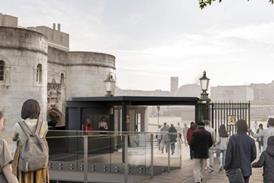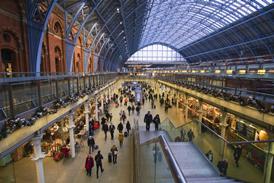When just one volume of building regs refers to 93 other documents, it’s clear that we need to go back to first principles, says Julia Park

The Great Fire of London lasted for four days and destroyed 13,200 houses, but only six people were recorded to have died. 350 years later, at least 79 people died in one building, in one night. The domino effect of the Grenfell Tower fire has been extraordinary and there is no end in sight. As well as profound sadness, there is a palpable sense of national shame. Alongside a meticulous investigation, there is a great deal of soul-searching.
The adequacy of Building Regulations will inevitably be questioned. Problems with the two volumes of Approved Document B (Fire Safety) begin on the cover. Volume 1 deals with ‘Dwellinghouses’ and Volume 2, with ‘Buildings other than dwellinghouses’.
‘Dwellinghouse’ is not a word we use. Defined only in Volume 1, it essentially means an individual house. It specifically excludes a flat, or a building containing a flat; these are dealt with in Volume 2. In planning Use Classes (the only other place the term seems to be used, albeit as two words), ‘Use Class C3 Dwelling houses’, covers houses and flats.
This is confusing in itself, but as many architects have been saying for years, ADB Volume 2 is also very complicated. It refers to 93 other documents of which 91 are British Standards, some costing over £300. BS 9991, ‘Fire safety in the design, management and use of residential buildings’, the document most frequently used by Building Control Officers and Approved Inspectors when dealing with blocks of flats, is not mentioned anywhere. Although a 2016 FAQ does mention BS 9999, it notes that BS 5588, (its withdrawn predecessor that also covered some key issues now dealt with in BS 9991) should be followed as ‘the legal presumption of conformity’.
Grenfell will almost certainly make the overdue update of Approved Document B a very high priority. I hope we see shorter, clearer documents, with a volume that deals with housing or dwellings (forget dwellinghouses), doesn’t rely on the purchase of supplementary publications, and goes back to first principles.
During a recent CPD seminar on fire safety that covered the long-established principle of ‘staying put’ in blocks of flats, the expert was asked whether he would remain in a building which he knew to be on fire. He said he would leave as quickly as possible. A quick show of hands revealed that we would all do the same. That doesn’t mean that staying put is unsafe or unwise, but it does suggest that it is counterintuitive to our natural instincts. That carries its own risks; particularly now, when it’s hard to imagine anyone choosing to stay put in a block of flats which has succumbed to fire.
ADB - Volume 2 is far from clear, even on this basic point: ‘This Approved Document has been prepared on the basis that, in an emergency, the occupants of any part of a building should be able to escape safely without any external assistance.’ (Paragraph B1i).
Grenfell has forced us to confront things we all know to be true but choose to deny
And that’s the next problem. Children, and many older, ill, disabled and partially sighted people will need help to escape. The AD does suggest that sheltered housing may need to be approached differently, but as 93% of us choose to remain in mainstream housing until we die or need residential care, that’s missing the point. Designers are expected to disperse flats for wheelchair users throughout the development. What should these residents do in a fire?
It’s difficult to see how a strategy that recommends that certain groups of people leave the building and others remain could be acceptable under the Equalities Act unless both options are equally safe. Surely that could only be achieved by providing a safe escape route for everyone who is able to escape (as we do in other building types) and installing sprinklers (as well as retaining compartmentalisation) for those who are unable to do so?
I think we will see dramatic changes to all Building Regulations as a direct result of the Grenfell fire. Even the newer ADs feel out of date in terms of language and current practice. The re-drafting must involve (and pay) experts from across the industry, including architects, to provide practical insight. We need a parallel review of planning Use Classes to achieve a more seamless transition from planning to building regulations.
Grenfell has forced us to confront other things we all know to be true but choose to deny. Since 2010, governments have been obsessed with deregulation; an endless stream of cost-cutting ‘Red Tape Challenges’ – the latest focusing on how to replace European laws. Top of Oliver Letwin’s new list (the man responsible for ‘One-in, Two-out’) is housebuilding. No one wants unnecessary rules but the industry has shown itself to be incapable of self-regulation, and for as long as profit remains the goal, that won’t change. We’ve almost forgotten that it’s normal for standards and regulation to improve gradually over time, and that with a decent lead-in period, that works.
As buildings get more complicated, more specialists are needed and accountability becomes more opaque. The RIBA has pointed out that changes to procurement (notably Design and Build) mean that projects frequently change hands and the design is often compromised; the demise of the Clerk of Works has left the client’s interests unprotected during construction too. And we’ve all noticed the impact of repeated cuts to public sector budgets. Under-resourced, and often under-skilled, local authority clients increasingly resort to expensive management consultants who don’t always give the best advice and are not always around by the time that becomes apparent. Just look at PFI.
Routine maintenance not only matters to residents, it saves money in the end. But most developers don’t need to think beyond the warranty period, and many landlords ignore issues for as long as they can. The Build to Rent sector has brought a shift in priorities. Many clients are now asking for higher specifications and designs that minimise and facilitate management and maintenance. Welcome though this is the underlying motive is still money – keeping tenants happy optimises revenue; and the buildings are increasingly institutional and mono-cultural.
Grenfell has also made us think about the true extent of social inequality: manifest most obviously in our living conditions. The Labour Party, National Housing Federation and Chartered Institute of Housing have all referred to the ‘demonisation of the poor’, crudely characterised as those who receive welfare payments. We don’t know what caused the fire but it seems clear that residents foresaw the possibility and were ignored, and that it probably could have been prevented. While natural disasters often result in even higher death tolls, every preventable death feels harder to bear.
I hope the public inquiry looks at all of this, even if that means a phased approach. As well as looking at regulation and where responsibility for fire safety should lie, it needs to consider what sort of housing we should be building, who should commission, fund, design, construct, supervise, inspect and manage it, who should live in it and how long it should last. For all the wrong reasons, politicians are under enormous pressure to think again. In the words of Camden’s council leader, “Grenfell changes everything.”
Postscript
Julia Park is head of housing research at Levitt Bernstein
















4 Readers' comments